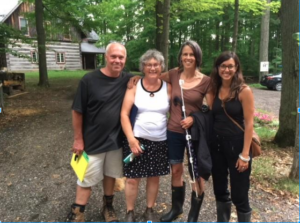A group of concerned citizens in and around Erin, Ontario have created a movement around regenerative agriculture. The momentum has been steadily building for several years and they are not done yet! This project demonstrates how a group of people from different paths can come together over a common concern and create a project which can make a difference.
On a trip through western Ontario this past summer, we made a stop at Heartwood Farm & Cidery, where we met Val Steinmann, co-owner, and agronomist, Ruth Knight. The two are key figures in the Erin Soil Health Coalition. They were just winding down a day of visits and citizen soil sample collecting.
A group of citizens preoccupied with climate change

A large number of Erin citizens have been preoccupied with environmental issues and climate change for some time. As early as 2010, people gathered for Transition Erin meetings, Eco-film Fest screenings, Awakening the Dreamer and Citizens’ Climate Lobby events. They asked themselves, what can we do locally? Because Erin is an agricultural community, the question of soil health and soil carbon was an appealing focus. They brought in Ruth Knight, a local agronomy consultant with a specialization in regenerative soil health practices in March 2017.
The project
The group team of twelve members went and got $2500 in funding from the local town government and made plans to host a movie night and a day long event for farmers in the area. They invited Peter Donovan of the Soil Carbon Coalition, a group which encourages local communities to take responsibility for their watershed region (the area of land that drains into rivers and lakes) by building soil carbon. Eighty people attended the event and the hosts asked participants if they were willing to commit to a long-term project of assessing efforts on their own land to increase soil carbon levels. Thirty landowners signed on for the challenge.
The next step was to get some funding for the project. Ruth Knight and core team member, JP Melville, wrote a grant proposal and obtained $70,000 in early 2018 from Friends of the Greenbelt Foundation. Then they started recruiting citizen scientists, regular people who were interested in donating their time to plotting off the test sites and collecting soil samples on the thirty sites. The control area on each site is a part on the edge of the field which is not treated with soil carbon building practices. The goal is to keep evaluating the progress on the thirty sites by measuring soil carbon and water infiltration rates in the treated area and compare it to the control area. The citizen scientists must take a half day training on the soil sampling methods and they do much of the legwork on the field days.
Together we make a difference
We were struck by the enthusiasm and community spirit of the group when we visited. Not only is this community raising awareness about soil health in their region and collecting some valuable data to validate regenerative agriculture methods, they are weaving bonds of friendship and camaraderie in their community and having fun while doing it. It is a wonderful example of how citizens can come together to make a difference!
Become a member of Regeneration Canada to find out more about initiatives like this one, and maybe even be a part of one!




